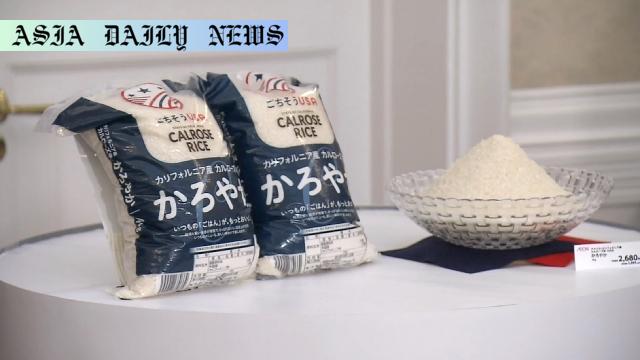Rice shortages drive Aeon to introduce California-grown Calrose, offering Japanese consumers an affordable and quality option.
Key Point 1: Aeon announced the sale of US-grown Calrose rice in Japan to combat local shortages and high prices.
Key Point 2: Calrose rice offers a lower-cost alternative, priced 10% less than traditional Japanese rice.
Key Point 3: Sales are scheduled from June to autumn, coinciding with Japan’s rice harvest season.
Key Point 4: Japan’s minimum access system mandates some rice imports while imposing high tariffs on surplus imports.

Aeon Introduces US-Grown Calrose Rice in Japan
In a groundbreaking initiative, retail giant Aeon is set to address Japan’s rice shortages and soaring prices by introducing California-grown Calrose rice to Japanese consumers. The decision, which was announced during a press conference held at the US Embassy in Tokyo, marks a significant milestone in Japan’s food import landscape. Starting from June 6, Calrose will be available in Aeon stores across Japan, offering an affordable alternative to domestically cultivated rice. The initiative is expected to provide relief to households grappling with the doubling of rice prices in local supermarkets when compared to the previous year.
Competitive Pricing Challenges Traditional Rice
Calrose will be sold in 4-kilogram bags priced at 2,894 yen (approximately $20), making it 10% cheaper than most Japanese rice. This strategic pricing not only provides a cost-effective option but also introduces Japanese consumers to a rice variety with distinct characteristics. Known for its lower stickiness, Calrose is particularly suited for dishes such as risotto and pilaf, offering culinary versatility. Aeon’s procurement efforts involve measures to navigate Japan’s complex tariff regulations, ensuring that the imported rice remains competitively priced despite added costs under the “minimum access” system and a tariff of $2.30 per kilogram for imports exceeding this quota.
Global Partnership and Cultural Exchange
The partnership between Aeon and Californian rice producers underscores the evolving dynamics of international trade and cultural appreciation. US Ambassador to Japan George Glass lauded the move, describing it as a “historic moment” for food-related partnerships between the US and Japan. As one of Japan’s leading supermarket chains, Aeon’s decision signals a growing willingness to embrace alternatives that meet consumer demands without compromising on quality. This shift is not just an economic decision but also an acknowledgment of the need to diversify food sources amid unpredictable agricultural challenges like climate change and the strain on local crop yields.
Looking at Challenges and Opportunities
Nevertheless, challenges remain as the Japanese market is notoriously discerning when it comes to taste, quality, and provenance of rice. Calrose’s lower stickiness might appeal to a niche segment but may not entirely satisfy the traditional palate of many Japanese consumers. Furthermore, local farmers may express concerns over competition from cheaper imports. However, Aeon aims to strategically end Calrose sales by autumn, aligning with the arrival of freshly harvested Japanese rice, which could alleviate potential opposition from domestic farmers. This temporary measure may pave the way for a balanced approach to addressing shortages while protecting local agricultural interests.
The Future of Imported Rice in Japan
Calrose’s entry into the Japanese market represents a cautious yet bold step in diversifying food supplies in a highly traditional industry. The initiative could set the stage for future collaborations and serve as a case study for other nations facing similar food security challenges. As Aeon and other retailers navigate this evolving market, consumer reception will ultimately determine the success of such endeavors. The experiment is as much about immediate relief from rising prices as it is about paving the way for longer-term changes in Japan’s consumption habits and food import policies.



Commentary
Implications of Aeon’s Move on Japan’s Rice Market
Japan’s rice market, steeped in tradition and quality, has faced significant disruptions owing to rising prices and supply shortages. Aeon’s decision to introduce US-grown Calrose rice is not just a business maneuver—it’s an acknowledgment of the challenges posed by supply chain issues and agricultural unpredictability. This move marks a pivotal moment, especially considering Japan’s stringent standards for rice quality, which reflect its deep cultural significance. By offering a competitively priced alternative, Aeon is addressing the twin concerns of affordability and availability, but the long-term implications of this decision remain to be seen.
Advantages of Calrose for Japanese Consumers
The introduction of Calrose offers consumers a chance to experiment with a different type of rice suited to diverse culinary applications. While traditional Japanese rice is celebrated for its stickiness and suitability for dishes like sushi, Calrose is better suited to Western-inspired meals such as risotto or pilaf. This versatility may appeal to younger generations who are more open to exploring international dishes, thereby contributing to the gradual evolution of Japan’s culinary landscape. For households seeking budget-friendly options without compromising on quality, Calrose provides a viable solution.
Balancing Economic and Cultural Pressures
However, the introduction of imported rice is not without its challenges. Japanese farmers and agricultural stakeholders may perceive this as a threat to the local industry, especially if consumers begin favoring cheaper imports over traditional offerings. Aeon’s plan to phase out Calrose sales by autumn is a thoughtful approach to mitigate such concerns, ensuring that domestic rice remains a staple of Japanese tables. This temporary solution, however, raises questions about the sustainability of relying on imports during periods of shortage. Perhaps, it is also a wake-up call for policymakers to consider strengthening domestic agricultural resilience.
Conclusion: A Tide of Change in Japan’s Food Market
Aeon’s move to sell US-grown Calrose is emblematic of broader shifts in global food trade and consumption patterns. While immediate relief for Japanese consumers is a positive outcome, the decision also underscores the complexities of balancing economic pragmatism with traditional values. As we witness this historic moment unfold, one cannot help but ponder its long-term ripple effects on Japan’s food industry and the global perception of its culinary heritage.